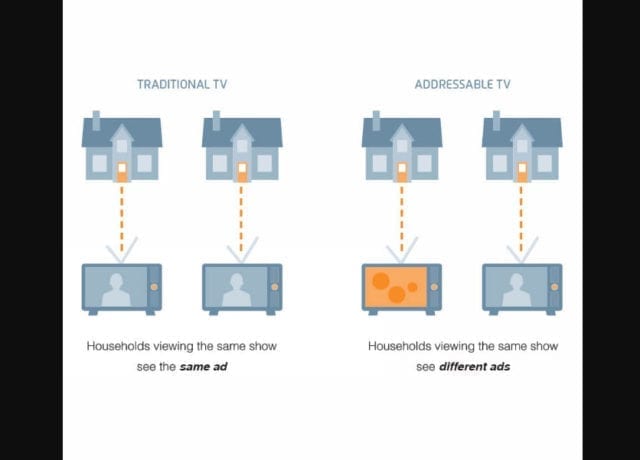The advertising industry as a whole has changed quite a bit in recent years. The same can certainly be said for the television advertising industry. The fact is, traditional TV advertisements are no longer cutting it, forcing the hand of the industry.
To innovate and maintain the same pace as other evolving ad formats, the television industry has made a number of notable strides.
One of the largest strides to rise to the surface recently has been the incorporation of addressable television advertising.
Addressable Television Advertising
Addressable TV advertising is the ability for a brand to present different advertisements to different viewers watching the same program. It presents a flexibility in television advertising that was not readily available in the past.
The technology has been around for a few years, but has only more recently gained real traction.
Because of the variety of devices that viewers now use to watch television, advertisements are not going to present the same value to everyone in every environment.
As a way to answer to the changing ways in which audiences absorb media, and maximize the value of advertising on TV, the television industry pushed forth addressable advertising.
This new trend could very well be the technology that re-separates television ads from other mediums.
What is it that makes addressable advertising so attractive to brands continuing to spend on television? A few things, actually. Let’s take a look at the many benefits that make addressable TV advertising one of the most prevalent trends in the industry.
Where There’s Data, There’s a Way
Addressable advertising utilizes data to optimize television advertising for brands, networks, and viewers like it’s never been done before. And instead of the traditional style of appealing to certain demographics, addressable advertising allows brands to target individuals based on a number of unique and more granular identifiers that go well beyond age and gender.
Unsurprisingly, it’s not taking brands long to buy in. According to Forrester, 17% of brands are already buying addressable TV spots, with another 20-30% planning on experimenting with the format in 2018.
Targeting People, not Programs
Personalization isn’t much of an option anymore when it comes to advertising mediums. Viewers demand an enjoyable experience no more than ever, making it important for the television industry to improve on some of the traditional means of presenting ads.
Addressable advertising appears to be a solution for that.
Instead of targeting based on the show that is playing, addressable advertising allows targeting strictly based on the individuals watching—regardless of device, time of day, or anything else.
From a brand’s perspective, addressable advertising allows for the ability to always present ads to relevant viewers, instead of simply playing to the masses, or trying to appeal to a room full of diverse people.
On the viewer’s side of things, the ads they’ll be receiving while watching television can now be more relevant, as well. This will lead to less disruption of the viewer experience, and therefore a higher level of enjoyment, and a higher level of engagement with the show at-hand.
In terms of presenting relevant content, addressable advertising seems to be a victory for all parties involved.
Bringing Geo-fencing to Traditional TV
One of the largest benefits of addressable advertising is the ability to target viewers within a specific location.
With over 3,000 counties in the U.S., for example, there are a great deal of ads that can be served to audiences tuning in to a nationally televised event.
To put traditional TV even further into perspective, Media Village previously wrote about the fact that Nielsen uses sample groups of around 40,000 family televisions to make their demographic approximations.
In a country with nearly 120 million TV homes, those numbers appear to be a bit arbitrary.
Addressable advertising only makes the stage bigger for big-time ad spots, as well, which could potentially push more brands to seek out spots that they normally would not, now that they do not have to worry about meeting a large amount of non-relevant eyeballs.
All-Inclusive Use
While addressable TV ads may be more useful for local or niche brands, because of the flexibility it presents, it can be useful for any advertising brand.
While brands with more niche offerings may spend a greater percentage of their ad spend on addressable advertising, large brands can still get a tremendous value out of the format, given the ability to scatter their message as they please, positioning their message in front of various audiences nationwide.
Brand-Safety
As has been the narrative for some time now, television advertising generally presents higher levels of brand safety than any other form of advertising. Addressable television is no different.
Brands can get all of the aforementioned benefits when choosing to spend on addressable ads, while retaining the safe-haven that the medium has presented itself to be.
Evolvability
Finally, in a constantly changing world where television sometimes seems to be at a disadvantage, addressable advertising presents a way for the TV medium to evolve as technology, as a whole, changes going forward.
As more and more TV viewing mediums are used by audiences, addressable advertising can simply be broken out for more granular demographic audiences. Therefore, as television viewing becomes more diverse across different audiences, the television industry will have no issues adjusting, thanks to the likes of addressable advertising.
Conclusion
In terms of addressable advertising, the U.S. is the most advanced across the globe, with over 50 million households available.
The addressable TV market is also estimated to bring in over $3 billion in ad spend in 2019. While that number represents only a fraction of all TV ad spend, it still represents a positive sign of growth.
The trend overall presents a lot to look forward to for the television industry, but also points to the fact that a lot of work is yet to come.
Addressable advertising is surely an improvement to traditional television advertising, but is by no means a solution. The OTT advertising industry will continue to be a massive and disruptive force.
For the time being, however, addressable ads are a minor victory for television, and a major step in the right direction.




